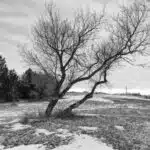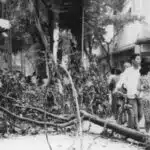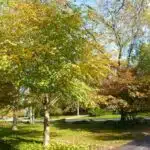As an arborist or professional tree care specialist, the art of cutting down a tree safely is one that requires extensive knowledge and experience. While it may seem like a simple task, there are several factors to consider before taking on such a project. Not only can improper tree removal be dangerous for those involved, but it can also cause damage to surrounding property and the environment.
Before beginning any tree removal project, it is essential to assess the situation thoroughly. This includes evaluating the size and location of the tree, as well as identifying any potential hazards in the area. Additionally, understanding proper cutting techniques and having the necessary equipment on hand can help ensure a safe and successful removal process. In this article, we will explore various tips and tricks for cutting down a tree safely while minimizing risks to both people and property.
Conducting A Thorough Assessment
Assessing the tree before cutting it down is critical for ensuring safety during the process. If done inadequately, there are high chances of injury and property damage. Therefore, it is necessary to conduct a thorough assessment that identifies potential hazards and develops risk mitigation strategies. The assessment should be done by a certified arborist or professional tree care specialist who understands the risks involved in felling trees.
The importance of conducting a thorough assessment cannot be overstated. It allows for identification of potential hazards such as dead branches, power lines, buildings, and other structures that may pose a threat during the felling process. A systematic approach to assessing the tree will help develop risk mitigation strategies that cater to each identified hazard. For instance, if there are power lines in close proximity to the tree, disconnecting them or requesting utility companies to do so should be part of the risk mitigation strategy.
Risk Mitigation Strategies should also include measures that ensure safety during the process. Such measures may include identifying escape routes in case something goes wrong during felling, securing equipment used for felling such as chainsaws and ropes, among others. Proper planning and implementation of risk mitigation strategies will go a long way in ensuring everyone’s safety during the process of cutting down a tree.
By conducting a thorough assessment and developing effective Risk Mitigation Strategies before cutting down a tree, you can significantly reduce any associated risks with this type of project. Identifying potential hazards is key to developing these strategies properly; this will allow you to put plans into place that mitigate any risks found during your evaluation period efficiently.
Identifying Potential Hazards
Assessing hazards is an essential step in cutting down a tree safely. Before starting the task, it is crucial to identify potential risks that may cause harm to yourself or others around you. Common hazards include nearby structures, power lines, uneven terrain, and the size and weight of the tree itself.
To manage these risks effectively, it is necessary to develop risk management strategies. The first step is to create a plan that outlines the safest approach for removing the tree. This plan should take into account any potential obstacles and determine the appropriate tools and equipment needed for the job. It’s also important to establish clear communication with anyone else who may be nearby during the removal process.
By assessing hazards and implementing effective risk management strategies, you can significantly reduce the likelihood of accidents or injuries while cutting down a tree. Taking these steps will help ensure that everyone involved remains safe throughout the process so that you can complete your task successfully.
Transition: Once you have assessed all potential hazards and created a comprehensive risk management plan, it’s time to move on to obtaining necessary permits and permissions before beginning work on cutting down your tree.
Obtaining Necessary Permits And Permissions
To start with, before you commence cutting down a tree, it is essential to obtain the necessary permits and permissions. Failing to do so can result in legal problems and hefty fines. An arborist or professional tree care specialist will be able to guide you through the process of applying for permits, as they have an understanding of the laws and regulations that govern tree removal in your area.
In addition to obtaining permits, community engagement is crucial when cutting down a tree safely. Even if it is on your private property, it’s essential to notify your neighbors of what you plan to do. It would be best if you also took into account any potential risks associated with removing the tree. For example, if there are power lines nearby, or if the tree has grown too close to other structures, it may pose significant risks that require additional precautions.
Before moving forward with any cutting down operations, ensure that you have all the necessary permits and permissions in place. Make sure that you have engaged with your community regarding your plans and have taken appropriate safety measures. Doing this not only protects you from legal consequences but also ensures that everyone involved remains safe throughout the process. With all these steps in mind, let’s move on to selecting the right tools and equipment for safe tree removal.
Selecting The Right Tools And Equipment
Now that you have obtained the necessary permits and permissions, it is time to move on to the next step in cutting down a tree safely. One of the most important aspects of this process is having the appropriate safety gear. This includes gloves, eye protection, ear protection, a hard hat, and sturdy work boots. It is crucial that you wear these items at all times during tree removal to prevent injury.
While some may choose to tackle tree removal on their own, it is highly recommended that you consider hiring professional tree removal services. Not only do they have the necessary experience and expertise to handle the job safely, but they also have access to specialized equipment that makes the process quicker and more efficient. Additionally, they will have insurance in case of any accidents or damages during the removal process.
In order to ensure a safe and successful tree removal process, selecting the right tools and equipment is essential. This includes chainsaws, ropes or cables for rigging, wedges for felling direction control, and ladders or aerial lifts for accessing high branches. It is important to carefully assess your needs before selecting equipment and always follow manufacturer instructions for proper use. In the next section we will discuss how properly maintaining equipment can contribute to a safe tree removal process.
Properly Maintaining Equipment
As an arborist or professional tree care specialist, it is essential to maintain the equipment properly to ensure safety and efficiency. Maintenance techniques vary depending on the type of equipment that you use. For chainsaws, sharpening the chain regularly is a crucial part of maintenance. A dull chain can cause the saw to kickback, which can be dangerous for the operator. Checking for leaks in fuel and oil tanks, replacing air filters, and cleaning debris from spark arrestors are other maintenance steps that should be performed periodically.
Safety gear essentials are another critical aspect of maintaining safety while cutting down trees. Personal protective equipment (PPE) such as helmets with face shields or visors, gloves, chaps or pants specifically designed for chainsaw operators, ear protection devices, and sturdy work boots must be worn at all times. Proper PPE ensures that operators remain safe from debris flying around during cutting activities.
Properly maintaining equipment and wearing appropriate PPE are just some steps towards ensuring a safe working environment while cutting down trees. The next section will delve into understanding cutting techniques further. It is important to learn about different types of cuts and how they affect the felling direction of a tree before getting started with any cutting activity.
Understanding Cutting Techniques
Properly maintaining equipment is crucial when it comes to tree removal. It is equally important to understand cutting techniques, especially when dealing with larger trees. Cutting angles and safety gear are two key components that should never be ignored.
Cutting angles are essential in ensuring a safe and controlled fall of the tree. The angle of cut will determine the direction of fall, which should be away from any structures or obstacles. A 45-degree angle is usually recommended for most trees, but specific species may require different angles. Additionally, cuts should not go deeper than one-third of the trunk’s diameter to avoid weakening the tree’s structure.
Safety gear is also critical in protecting yourself during tree removal. A helmet, eye and ear protection, gloves, steel-toed boots, and chainsaw chaps are all necessary gear to have on hand. Chainsaws can cause severe injuries if not handled correctly or if protective gear is not worn.
Determining the direction of fall is the next step in safely cutting down a tree. This involves assessing the tree’s lean and determining where it would naturally fall. Factors such as wind direction and surrounding obstacles need to be considered before making any cuts. By following these steps and using proper equipment, you can ensure a safe and successful tree removal process.
Determining The Direction Of Fall
- Identifying the lean of the tree is essential for safely cutting it down, as the lean of the tree will direct the direction of the fall.
- Analyzing wind direction is also important for determining the direction of the fall, as wind can push a tree in a certain direction.
- Arborists and professional tree care specialists should assess the lean of a tree before attempting to cut it down in order to minimize potential risk.
- Additionally, tree care specialists should consider wind direction when determining the direction of fall, in order to ensure that the tree will fall in the intended direction.
Identifying The Lean
Identifying the lean of a tree is crucial when determining the direction of fall and ensuring safety during the cutting process. The importance of leaning cannot be emphasized enough as it plays a significant role in predicting where the tree will fall. Arborists must take into account not only the direction of leaning but also its degree, which can affect how the tree will behave when cut. Failing to identify the lean accurately can result in injury or damage to property.
Leaning and weight distribution are two distinct concepts that arborists must differentiate to determine the direction of fall. While weight distribution refers to how evenly distributed weight is across the trunk, leaning pertains to the angle at which a tree leans in a particular direction. Weight distribution may play a part in determining where branches will fall, but it does not necessarily determine where the entire tree will land. On the other hand, leaning provides insight into which way the whole tree is most likely to fall.
To identify a tree’s lean accurately, an arborist must analyze various factors such as soil type, wind exposure, and any physical defects present in the trunk or branches. These considerations enable them to predict with reasonable accuracy where a tree will land and plan a safe felling operation accordingly. It is essential for arborists to pay close attention to these details as they ensure that everyone involved is safe during and after felling operations.
Analyzing Wind Direction
Determining the direction of fall is crucial in any tree felling operation, and arborists must consider various factors to ensure safety. One important factor that arborists need to analyze is wind speed and direction. Analyzing wind direction is an essential aspect of determining the direction of fall as it affects how a tree falls. Wind can push or pull trees in different directions, depending on its strength and direction, which can cause significant problems if not taken into account.
Arborists must assess wind speed and direction before felling a tree to determine the safest way to cut it down. Analyzing wind patterns helps arborists predict how the tree will sway during cutting, which helps them plan where to drop branches, position ropes or pulleys, and plan their escape route. By understanding the movement of air currents around a tree, arborists can determine which side of the tree would be safer for them to work on or whether they should postpone cutting until weather conditions change.
Using ropes is another technique that arborists use to control the direction of fall when dealing with trees with unpredictable leaning or weight distribution. Ropes can help guide trees safely when there are obstacles nearby or when a tree leans towards a dangerous area. Arborists attach ropes at strategic points on a tree trunk using specialized knots and pulleys that allow them to control its movement during cutting. Properly positioned ropes provide additional support while also enabling arborists to direct the falling trunk away from hazards such as buildings or power lines.
In conclusion, analyzing wind speed and direction is crucial when determining the direction of fall in any felling operation. Wind has a significant impact on how trees behave during cutting; hence it’s essential for arborists always to take this factor into account before starting any felling process. Using ropes is another method that arborists use to control falling trees’ movement safely while minimizing damage to surrounding property or people involved in the operation. Proper planning and execution are necessary for a safe and successful felling operation, which requires arborists to be knowledgeable and experienced in the field.
Creating An Escape Route
Escape route planning is an essential aspect of cutting down a tree safely. An escape route is a predetermined path that the cutter will take when the tree starts to fall. It should be clear and free from any obstruction, such as rocks, logs, or other debris that may cause tripping or stumbling. The route should be planned beforehand, taking into account the direction of fall and potential obstacles.
Before starting to cut the tree, it is crucial to select adequate safety gear. Personal protective equipment (PPE) should include a hard hat, eye and ear protection, gloves, and appropriate footwear. A chainsaw-resistant legging can also provide additional protection against cuts from a chainsaw blade. Ensure that all PPE fits correctly and is in good condition before starting any work.
When selecting an escape route, consider several factors such as the slope of the terrain, wind direction, obstacles around the tree’s base, and any structures nearby. Always choose an escape path perpendicular to the falling direction of the tree. Avoid running directly behind or in front of the falling tree as this can lead to severe injury or death if it falls in an unexpected direction. Plan your way out so that you don’t have to look back while escaping.
Transition: Once you have selected your escape route and are wearing appropriate gear, it’s time for making the first cut.
Making The First Cut
When it comes to cutting down a tree safely, making the first cut is crucial. The first step in this process is to ensure that you are standing with proper posture. You should stand with your feet shoulder-width apart and keep your knees slightly bent, which will help you maintain balance and prevent injury.
Before making the first cut, it’s important to make sure that your saw blade is sharp. A dull blade can be dangerous because it requires more force to make cuts, which can cause the saw to kick back or bind in the wood. Sharpening your blade before starting work will not only make your job easier but will also make it safer by reducing the risk of accidents.
By following these simple guidelines for proper posture and blade sharpening, you can increase your chances of making a successful felling cut. The next section will cover creating the felling cut itself, which is another critical step in ensuring that you cut down your tree safely and effectively without causing any damage to yourself or anyone else around you.
Creating The Felling Cut
After making the first cut, the next step in cutting down a tree safely is creating the felling cut. This involves making a horizontal cut on the opposite side of the tree from where you made your first cut. The felling cut should be perpendicular to the direction of fall and at a higher level than the first cut.
One key aspect of creating a safe felling cut is ensuring that it is made at the correct angle. The angle measurement will vary depending on the size and species of the tree, as well as its lean and shape. Arborists use specialized tools to accurately measure this angle before making their felling cut, which helps to prevent trees from falling in unintended directions or causing damage during removal.
Another important consideration when creating a felling cut is wedge placement. Depending on certain factors such as wind direction and lean, wedges may need to be placed in strategic locations to help guide the tree’s fall in a safe manner. Wedges are typically made from wood or plastic and are driven into cuts made in the tree trunk to create leverage and control over its falling direction. Properly placed wedges can help prevent trees from falling onto structures or causing harm to individuals nearby.
To ensure safe distance from the tree during cutting, it’s important for anyone involved with its removal to stay alert and aware of their surroundings at all times. Before beginning any cutting operations, it’s essential to establish clear safety zones around the tree where individuals are not allowed to enter until work has been completed. Additionally, wearing protective gear such as hard hats, eye protection, and sturdy clothing can help minimize injuries in case of unexpected accidents during removal operations.
Ensuring Safe Distance From The Tree
- When assessing the risk of cutting a tree, a professional arborist should consider the size, location and condition of the tree.
- The height of the tree should be measured to ensure that the tree can be safely cut down.
- The arborist should also consider other risks such as the potential for falling branches or obstacles around the tree.
- A qualified arborist should be consulted to ensure that the necessary safety precautions are taken when cutting down a tree.
Assessing Risk
Assessing the potential risks involved in cutting down a tree is essential to ensure safety during the process. The importance of risk assessment cannot be overstated, as it helps identify any hazards that may pose a danger to the workers or bystanders. The process of risk assessment involves evaluating the tree’s size, shape, and structure, as well as its proximity to nearby structures, power lines, and other obstacles.
To ensure safe distance from the tree during cutting down operations, appropriate safety measures must be put in place. This includes using specialized equipment such as hard hats, safety glasses, gloves, and ear protection. Arborists and professional tree care specialists should also undergo extensive training on proper cutting techniques and safety procedures before initiating any operation. Having experienced personnel present at all times can help mitigate any unforeseen risks that may arise during the process.
In conclusion, assessing the potential risks involved in cutting down a tree is crucial for ensuring safe distance from the tree during operations. Arborists and professional tree care specialists should prioritize safety by implementing appropriate safety measures such as wearing protective gear and undergoing specialized training. By doing so, they can reduce the likelihood of accidents or injuries occurring while carrying out their work.
Measuring Tree Height
Measuring tree height is another important aspect of ensuring safe distance from the tree during operations. Accurate measurement of the tree’s height is crucial to determine the appropriate equipment needed for cutting, as well as the safety measures required. Arborists and professional tree care specialists use various methods to measure a tree’s height, including laser rangefinders, clinometers, and hypsometers.
The accuracy of measuring tree height is essential in calculating the potential risks involved in cutting down a tree. A slight miscalculation can lead to severe accidents or injuries during operations. Therefore, arborists must ensure that they use reliable equipment and techniques for measuring a tree’s height accurately. They should also consider factors such as slope, terrain, and nearby obstacles that may affect their measurements.
In conclusion, measuring a tree’s height is critical in ensuring safe distance from the tree during operations. Arborists and professional tree care specialists should prioritize accuracy when calculating heights to reduce the likelihood of accidents or injuries occurring while carrying out their work. By doing so, they can provide efficient and effective services to their clients while maintaining safety standards.
Removing The Tree Stump
After cutting down a tree, one of the essential tasks is removing the stump. Stumps can cause problems for landscaping and can harbor pests and diseases. There are different methods to remove stumps, such as digging them out, applying chemicals, or using specialized equipment. Arborists use techniques that are safe for humans and the environment.
One of the stump removal techniques that arborists use is grinding. Stump grinding equipment uses a rotating disk with teeth to grind down the stump into small wood chips. The size of the equipment depends on the size of the stump, and it can vary from small machines for residential landscapes to larger ones for commercial sites. Grinding leaves behind wood chips that can be used as mulch or removed from site.
When considering stump removal techniques, it’s important to choose an option that suits your needs and budget. Digging out stumps by hand is labor-intensive and time-consuming but may be suitable for smaller stumps in areas with no underground utilities or structures. Chemicals are also an option but require careful handling and may take longer to decompose the stump fully. Hiring a professional arborist with experience in stump removal provides peace of mind knowing that they will use safe and effective methods like grinding with specialized equipment.
Stump removal is a crucial step in tree care that should not be overlooked after felling a tree. After removing the stump, it’s essential to clean up debris thoroughly before replanting or starting any landscaping projects in the area. In upcoming sections, we’ll discuss different ways to clean up debris effectively without causing damage to your yard or property.
Cleaning Up Debris
As a professional tree care specialist, I have seen firsthand the amount of debris that is left after cutting down a tree. It can be overwhelming and dangerous if not properly disposed of. The best way to approach this task is by being cautious and responsible.
Debris disposal is an essential part of tree removal. When cleaning up after cutting down a tree, it’s crucial to ensure that all debris is cleared away from the site. This includes all branches, twigs, and leaves that may have fallen during the process. Not only does this help prevent accidents from occurring, but it also reduces the environmental impact of the job.
It’s important to note that improperly disposing of waste can cause serious harm to our environment. Many people don’t realize that simply dumping debris in their backyard or burning it can release harmful chemicals into the air and soil. Instead, consider contacting a local waste management company or recycling center for guidance on how to dispose of your debris properly. By doing so, you’ll not only be protecting the environment but also ensuring your safety and those around you as well.
With proper planning, cleaning up debris after cutting down a tree can be both safe and environmentally friendly. In the next section, we will discuss how to dispose of waste properly without causing harm to our surroundings.
Disposing Of Waste Properly
After cutting down a tree, the next step is to dispose of the waste properly. Keeping in mind that trees play an important role in our ecosystem, it is essential to ensure that every part of the tree is utilized efficiently. One way of doing this is recycling wood chips and composting branches.
Recycling wood chips can be done by contacting your local government or tree care companies. Many companies collect wood chips and use them for different purposes such as landscaping and gardening. Recycling wood chips provides an eco-friendly solution for disposing of waste while also providing benefits to your community.
Composting tree branches is another way to dispose of waste properly. Composting involves breaking down organic material into nutrient-rich soil that can be used for gardening or farming. Tree branches can be chipped into small pieces and mixed with other organic matter such as leaves, grass clippings, and food scraps to create compost. This process not only reduces waste but also provides a sustainable source of nutrients for plants.
By recycling wood chips and composting tree branches, we can reduce the amount of waste going into landfills while also contributing to a healthier environment. Proper disposal of tree waste ensures that every part of the tree is utilized effectively, reducing our impact on the environment. In the next section, we will discuss how evaluating results and learning from experience can help us improve our techniques when cutting down trees.
Evaluating The Results And Learning From Experience
After completing the task of cutting down a tree, it is crucial to engage in a reflection process where one can evaluate the results. This would involve assessing the execution of the safety protocols that were put in place during the felling process. Were they effective? Did they ensure that everyone involved was safe? Answering these questions would help identify areas that need improvement and enhance safety measures for future tree-cutting projects.
One important aspect of evaluating the results is examining any incidents or near-misses that occurred during the process. Such analysis helps identify potential hazards and risks, which can be addressed through improved safety protocols. It is essential to document all incidents regardless of how minor they may seem, as this information can inform future safety practices, thereby preventing accidents.
To improve safety protocols, it is necessary to learn from past experiences. By reflecting on previous projects and identifying areas that need improvement, individuals can develop better strategies for executing tree-cutting tasks safely. Furthermore, sharing these experiences with other arborists or tree care specialists can help create a culture of safety within the industry, encouraging everyone involved to prioritize safety first.
In summary, evaluating results after cutting down a tree involves reflecting on executed safety protocols and analyzing any incidents or near-misses that occurred during the task. By learning from past experiences, individuals can improve their approach to felling trees safely and share such insights with others in their field. Ultimately, prioritizing safety should always remain paramount for all professionals who work in this industry.
Conclusion
Cutting down a tree can be a daunting task, but with proper planning, equipment and knowledge one can do it safely. Before starting the process, it’s essential to conduct a thorough assessment of the tree’s condition and surroundings. Identifying potential hazards such as obstacles or power lines is crucial to ensure safety during the felling process. Obtaining necessary permits and permissions from local authorities is also vital.
Choosing the right tools and equipment is equally important. Maintaining them properly before and after use ensures optimal performance. Removing the stump must be done with care to avoid damage to surrounding structures or plants. Cleaning up debris should follow immediately after felling to ensure that no further accidents are caused by tripping over branches or logs.
In conclusion, cutting down trees is not something that should be taken lightly. It requires careful planning, execution, and post-felling evaluation. The importance of proper training and equipment cannot be overstated when undertaking this task. By following these steps, one can cut down a tree safely while minimizing any negative impact on the environment. So ask yourself: Are you ready to take on this challenge?
Image Credits





























